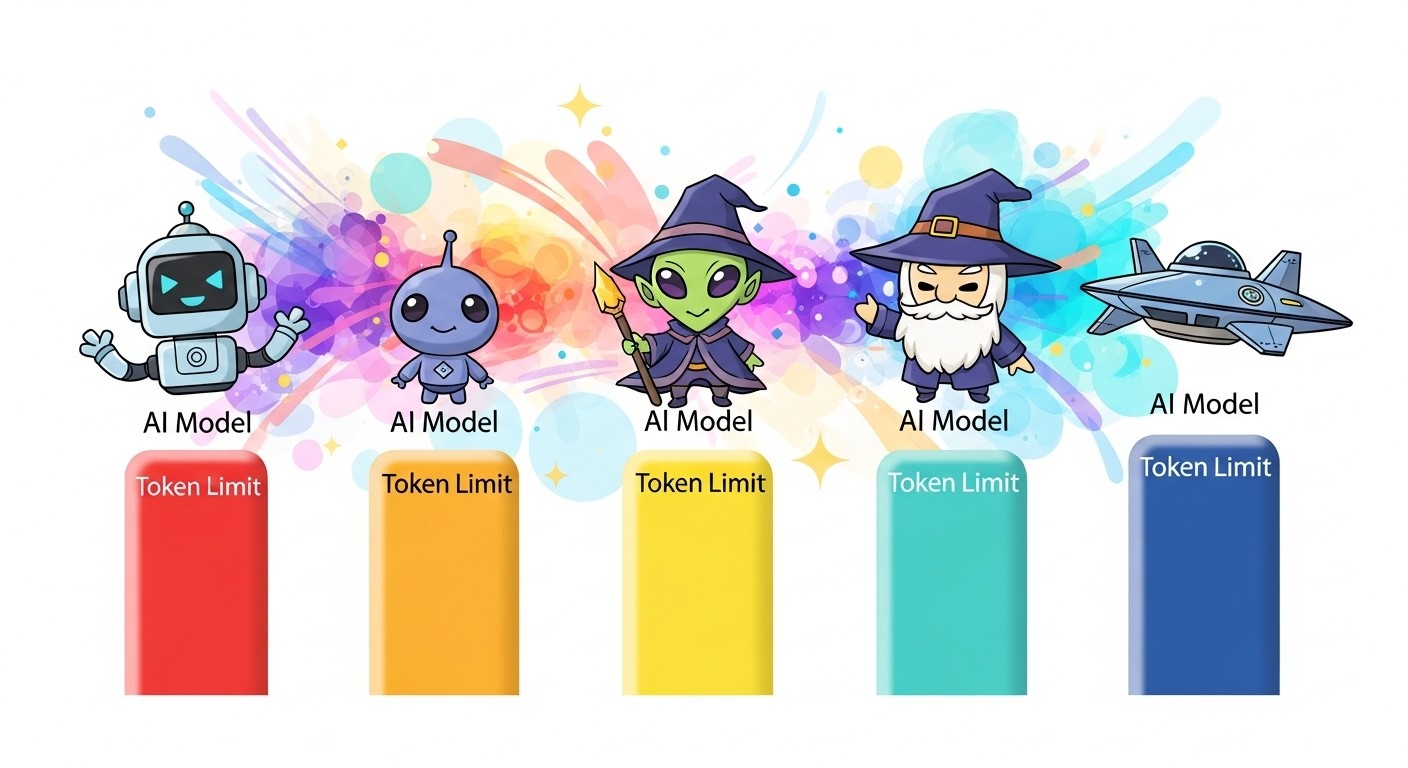Anthropic Claude 4 Breaks AI Context Barriers with 1M Tokens

Anthropic just shattered one of the most fundamental limitations in AI development. Claude Sonnet 4 now supports up to 1 million tokens of context, a massive 5x increase that fundamentally changes how developers and researchers can interact with large language models. This breakthrough enables processing entire codebases containing over 75,000 lines of code in a single request.
Link to section: Understanding the Token Context RevolutionUnderstanding the Token Context Revolution
To grasp why this matters, imagine trying to have a conversation about a complex novel while only being able to remember the last few pages at any given time. That's essentially how most AI models have operated until now. A "token" in AI terms represents roughly 3-4 characters of text, so 1 million tokens translates to approximately 750,000 words of text that the model can actively consider simultaneously.
Previous versions of Claude Sonnet supported 200,000 tokens, which already exceeded many competitors. GPT-4 Turbo tops out at 128,000 tokens, while GPT-4o handles 128,000 tokens as well. Claude's jump to 1 million tokens represents a quantum leap in capability that dwarfs existing alternatives.
The technical achievement behind this expansion involves sophisticated memory management and attention mechanisms that allow the model to maintain coherent understanding across vastly longer inputs without proportionally increasing computational costs. Anthropic's engineering team developed novel approaches to handle the quadratic scaling challenges that typically plague transformer architectures as context length increases.
Link to section: Breaking Down Real-World ApplicationsBreaking Down Real-World Applications
The 1 million token context window unlocks entirely new categories of AI-assisted work. For software developers, this means uploading entire repositories including source files, documentation, tests, and configuration files. Claude can then understand the complete project architecture, identify cross-file dependencies, and suggest improvements that account for the entire system design rather than isolated code snippets.
Bolt.new, a browser-based development platform, has already integrated this capability into their workflow. CEO Eric Simons explains that developers can now work on significantly larger projects while maintaining the high accuracy needed for real-world coding applications. The platform uses Claude Sonnet 4 as their primary model for code generation, and the expanded context allows them to handle enterprise-scale applications that were previously impossible to process holistically.
Legal professionals can now analyze comprehensive contract portfolios, processing hundreds of documents simultaneously to identify patterns, conflicts, or compliance issues across an entire legal framework. Research teams can upload dozens of academic papers and have Claude synthesize findings while maintaining awareness of subtle connections between different studies.

Link to section: Technical Implementation and ArchitectureTechnical Implementation and Architecture
The engineering behind 1 million token support required fundamental advances in how attention mechanisms scale. Traditional transformer architectures suffer from quadratic complexity as context length increases, meaning that doubling the context length roughly quadruples the computational requirements. Anthropic's solution involves a combination of optimized attention patterns, memory-efficient implementations, and novel caching strategies.
The model uses a hierarchical attention mechanism that can efficiently process long sequences by identifying which parts of the context are most relevant for generating each token. This selective attention approach prevents the model from being overwhelmed by irrelevant information while ensuring that crucial details from anywhere in the 1 million token window remain accessible.
Claude Sonnet 4 also implements advanced prompt caching, which allows frequently used portions of large contexts to be cached and reused across multiple requests. This dramatically reduces both latency and computational costs for workflows involving repeated analysis of large document sets or codebases.
Link to section: Pricing Structure and Economic ImpactPricing Structure and Economic Impact
Anthropic has implemented tiered pricing to reflect the increased computational requirements of processing extended contexts. For prompts containing 200,000 tokens or fewer, pricing remains at $3 per million input tokens and $15 per million output tokens. However, prompts exceeding 200,000 tokens are priced at $6 per million input tokens and $22.50 per million output tokens.
This pricing structure reflects the technical reality that processing longer contexts requires significantly more computational resources. However, when combined with prompt caching capabilities, users can achieve substantial cost savings for iterative workflows involving large documents or codebases. The batch processing option provides an additional 50% cost reduction for non-time-sensitive applications.
The economic implications extend beyond direct usage costs. Development teams report 30-40% reductions in project planning time when they can upload entire specification documents and have Claude provide comprehensive analysis and recommendations. Legal firms processing large contract portfolios see similar efficiency gains, with some reporting that document review times have decreased by over 50%.
Link to section: Competitive Landscape and Industry ResponseCompetitive Landscape and Industry Response
Claude's 1 million token breakthrough has intensified competition in the large language model space. OpenAI's GPT-4 models currently max out at 128,000 tokens, while Google's Gemini Pro supports up to 1 million tokens but with different performance characteristics and availability limitations.
The gap is particularly significant for enterprise applications where document processing and code analysis are core use cases. Recent funding patterns show investors increasingly prioritizing AI companies with superior context handling capabilities, recognizing that longer context windows translate directly into more valuable enterprise applications.
Microsoft has hinted at similar capabilities coming to GPT-4o, but no concrete timeline has been announced. Google's Gemini models technically support 1 million tokens but with significant performance degradation at maximum context length, making Claude's implementation more practically useful for sustained workflows.
Link to section: Developer Integration and Tool EcosystemDeveloper Integration and Tool Ecosystem
Integration with existing development workflows has been streamlined through comprehensive API support and partnerships with major cloud platforms. Claude Sonnet 4 with 1 million token support is available through the Anthropic API for customers with Tier 4 and custom rate limits, with broader availability rolling out over the coming weeks.
Amazon Bedrock provides fully managed access to the expanded model, allowing enterprise customers to integrate long-context capabilities without managing infrastructure. Google Cloud's Vertex AI integration is scheduled to launch soon, providing additional deployment options for organizations with existing Google Cloud commitments.
The model integrates seamlessly with popular development environments through API calls that can handle entire project directories. iGent AI's Maestro software engineering agent demonstrates the potential, enabling multi-day development sessions on real-world codebases with autonomous code generation and modification capabilities.
Link to section: Limitations and ConsiderationsLimitations and Considerations
Despite the breakthrough, the 1 million token context window isn't without limitations. Processing extremely long contexts still requires significant computational time, with complex analyses potentially taking several minutes rather than the near-instantaneous responses typical of shorter prompts. Anthropic recommends using their streaming API for longer requests to avoid timeouts.
The model's performance can vary depending on how information is distributed throughout the long context. Critical information placed in the middle of very long documents may receive less attention than information at the beginning or end, a phenomenon known as the "lost in the middle" problem that affects all large language models to some degree.
Quality of responses also depends heavily on the structure and relevance of the input context. Simply uploading massive amounts of loosely related text won't produce better results than a carefully curated, smaller context that focuses on the specific problem at hand.
Link to section: Security and Privacy ImplicationsSecurity and Privacy Implications
Extended context windows raise important questions about data handling and privacy. Organizations uploading entire codebases or comprehensive document sets need assurance that sensitive information remains secure. Anthropic has implemented enhanced security measures for long-context requests, including improved data isolation and audit logging capabilities.
The ability to process such large contexts also creates new possibilities for inadvertent data leakage. Organizations must carefully review what information they include in extended context requests, as the model will have access to everything provided simultaneously. This requires updating data governance policies to account for AI workflows that can process vastly more information than traditional tools.
Enterprise customers working with sensitive codebases or confidential documents should consider using dedicated deployments or on-premises solutions to maintain complete control over data handling. Anthropic offers enterprise-grade deployment options that provide additional security controls for organizations with strict compliance requirements.
Link to section: Future Implications and Research DirectionsFuture Implications and Research Directions
The 1 million token breakthrough represents more than just a quantitative improvement; it suggests qualitative changes in how AI systems can assist with complex, interconnected problems. Research teams are already exploring applications in scientific literature analysis, where Claude can process entire research domains to identify novel connections and research opportunities.
The technology also opens new possibilities for AI agents that can maintain context across extended interactions and complex workflows. Multi-step reasoning tasks that previously required breaking problems into smaller chunks can now be handled holistically, potentially leading to more coherent and sophisticated AI assistance.
Looking ahead, the race toward even longer context windows continues. Anthropic researchers have published papers exploring context lengths exceeding 10 million tokens, though practical implementations face significant computational and cost challenges. The eventual goal is context windows large enough to process entire knowledge domains, essentially creating AI systems with comprehensive understanding of specific fields.
Link to section: Getting Started with Long ContextGetting Started with Long Context
For developers interested in leveraging the 1 million token capability, the most effective approach involves careful prompt engineering and context organization. Structure large inputs with clear headings and logical organization to help the model navigate the extensive context effectively.
Start by identifying use cases where the expanded context provides genuine value rather than simply uploading large amounts of text. The most effective applications involve scenarios where understanding relationships between disparate pieces of information is crucial, such as analyzing codebases for architectural decisions or reviewing document collections for policy consistency.
Testing should begin with smaller contexts to establish baseline performance before scaling up to the full 1 million token capacity. This helps identify optimal prompt structures and allows for cost estimation before committing to large-scale implementations.
The breakthrough in AI context handling represents a fundamental shift in what's possible with language models. As context windows continue to expand and costs decrease, we're moving toward AI systems that can truly understand and work with the full complexity of real-world problems, rather than simplified abstractions. This technological leap positions Claude Sonnet 4 at the forefront of practical AI applications, setting new standards for what developers and researchers can accomplish with artificial intelligence assistance.

